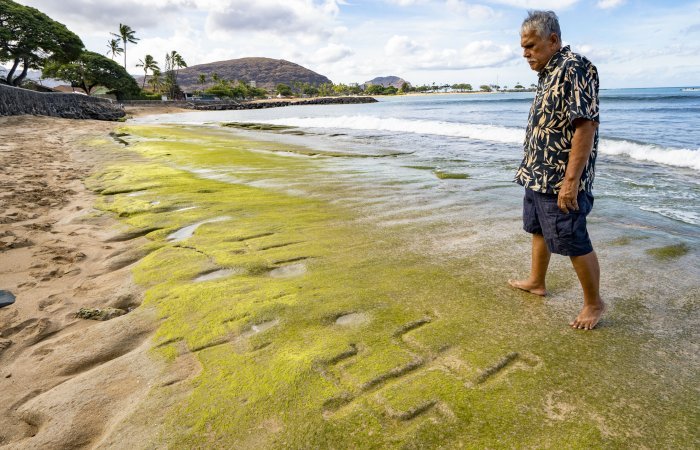Jan Bartek – AncientPages.com – Hawaiian petroglyphs, which date back at least 500 years, have recently become visible on Oahu for the first time in several years. Seasonal ocean swells have uncovered a panel featuring over two dozen images, primarily depicting human-like stick figures. Among these is a figure that some suggest may represent Maui, a “trickster hero” in Polynesian mythology known for his magical powers and often regarded as a demigod.
Cultural practitioner Glen Kila walks around the petroglyphs carved into the rock at Pokai Bay during low tide, July 22, 2025, in Waianae, Hawaii. Credit: AP Photo/Mengshin Lin
These petroglyphs can be easily observed during low tide when gentle waves reveal them amidst slippery, neon-green algae on sandstone. This marks the first occasion since their discovery nine years ago by visitors at a bayside U.S. Army recreation center in Waianae—about an hour from Honolulu—that the entire panel has been visible.
Glen Kila, a Native Hawaiian cultural practitioner with ancestral ties to this coastal Hawaii community, interprets the reappearance of these petroglyphs as an ancestral message about rising ocean levels. Kila, an expert on Waianae’s culture and history who is advising the Army on protecting these artifacts.
Army officials are working to find a balance between preserving the petroglyphs and ensuring they remain accessible to the public on a beach. This involves implementing measures that protect these historical artifacts while allowing visitors to appreciate their cultural significance.
According to Kila’s studies, the lineal petroglyphs seem to depict a religious or ceremonial narrative. He interprets the largest figure, characterized by hands and fingers with one arm raised and the other lowered, as symbolizing the rising and setting sun.
Maui. Credit: – Public Domain
Emphasizing Maui’s importance, “Maui played a role in our mo’olelo here,” he noted. The positioning of fingers from east to west symbolizes a religious significance akin to that of symbols like the cross in Christianity. Mo’olelo refers to Hawaiian stories encompassing myth, history, tradition, and literature.
Dating petroglyphs poses a challenge, but an archaeological site nearby dates back approximately 600 years, according to Laura Gilda, an archaeologist with U.S. Army Garrison Hawaii. Kila notes that Hawaiians settled in Waianae at least 1,000 years ago. The beach in this area changes in size and shape annually due to the formation of low-pressure weather systems in the eastern Pacific from May to November. These systems generate waves that erode loose sand from the shorelines and redeposit it further out, as detailed in an Army report on the petroglyphs. This natural process likely leads to their temporary exposure.
Archaeologists have identified a total of 26 petroglyphs at the site. Among these are 18 anthropomorphic stick figures; eight appear to have male genitalia while the gender of the others remains undetermined, according to the report. The entire panel extends approximately 115 feet (35 meters) in length, Gilda stated.
Petroglyphs have reemerged on an Oahu beach. Credit: U.S. Army Garrison Hawaii
The petroglyphs first reappeared in July 2016 following late spring and early summer storms—including hurricanes—that caused significant wave activity sweeping away sand cover, Gilda explained. They were visible for some time before becoming covered once again.
“So there’s been portions that have … been exposed since then, but this is the first summer that the whole panel has been exposed again,” Gilda said.
See also: More Archaeology News
Donald Kauli’a, a Native Hawaiian originally from Waianae, captured images of the petroglyphs. He expressed that viewing these ancient carvings provides a sense of confirmation about the presence and heritage of their ancestors in the area.
Efforts by archaeologists and the Army aim to safeguard this site, yet they acknowledge that natural forces will eventually reclaim it. As sand shifts and tides rise, these carvings will periodically disappear from view, only to be revealed again with changing seasons.
Written by Jan Bartek – AncientPages.com Staff Writer








